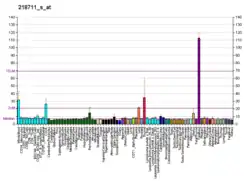SDPR
Cavin-2 or Serum deprivation-response protein (SDPR) is a protein that in humans is encoded by the SDPR gene.[5][6][7] Cavin-2 is highly expressed in a variety of human endothelial cells.[8]
| CAVIN2 | |||||||||||||||||||||||||
|---|---|---|---|---|---|---|---|---|---|---|---|---|---|---|---|---|---|---|---|---|---|---|---|---|---|
| Identifiers | |||||||||||||||||||||||||
| Aliases | CAVIN2, PS-p68, SDR, cavin-2, SDPR, serum deprivation response, caveolae associated protein 2 | ||||||||||||||||||||||||
| External IDs | OMIM: 606728 MGI: 99513 HomoloGene: 3422 GeneCards: CAVIN2 | ||||||||||||||||||||||||
| |||||||||||||||||||||||||
| |||||||||||||||||||||||||
| |||||||||||||||||||||||||
| |||||||||||||||||||||||||
| Orthologs | |||||||||||||||||||||||||
| Species | Human | Mouse | |||||||||||||||||||||||
| Entrez | |||||||||||||||||||||||||
| Ensembl | |||||||||||||||||||||||||
| UniProt | |||||||||||||||||||||||||
| RefSeq (mRNA) | |||||||||||||||||||||||||
| RefSeq (protein) | |||||||||||||||||||||||||
| Location (UCSC) | Chr 2: 191.83 – 191.85 Mb | Chr 1: 51.29 – 51.3 Mb | |||||||||||||||||||||||
| PubMed search | [3] | [4] | |||||||||||||||||||||||
| Wikidata | |||||||||||||||||||||||||
| |||||||||||||||||||||||||
This gene encodes a calcium-independent phospholipid-binding protein whose expression increases in serum-starved cells. This protein has also been shown to be a substrate for protein kinase C (PKC) phosphorylation.[7]
Function
Cavin-2 is required for blood vessel formation (angiogenesis) in humans and zebrafish and required also for the endothelial cell proliferation, migration and invasion in humans.[8] Cavin-2 plays an important role in endothelial cell maintenance by regulating eNOS activity.[8] Cavin-2 controls the generation of nitric oxide (NO) in human endothelial cells by controlling the activity and stability of the protein endothelial nitric-oxide synthase (eNOS).[8]
Secretion
Cavin-2 is highly secreted from human endothelial cells (HUVEC), they are secreted through endothelial microparticles (EMPs) but not exosomes and is required for EMP biogenesis.[8]
Clinical significance
SDPR is shown to act as a metastasis suppressor by xenograft studies utilizing breast cancer cell lines.[9] SDPR may elicit its metastasis suppressor function by directly interacting with ERK and limiting its pro-survival role.[9] Moreover, it is suggested that SDPR is silenced during breast cancer progression by promoter DNA methylation.[9] Metastasis suppressor role of SDPR may go beyond breast cancer since tumor samples from bladder, colorectal, lung, pancreatic, and ovarian cancers as well as sarcomas also exhibited loss of SDPR expression.[9]
References
- GRCh38: Ensembl release 89: ENSG00000168497 - Ensembl, May 2017
- GRCm38: Ensembl release 89: ENSMUSG00000045954 - Ensembl, May 2017
- "Human PubMed Reference:". National Center for Biotechnology Information, U.S. National Library of Medicine.
- "Mouse PubMed Reference:". National Center for Biotechnology Information, U.S. National Library of Medicine.
- Gustincich S, Vatta P, Goruppi S, Wolf M, Saccone S, Della Valle G, et al. (April 1999). "The human serum deprivation response gene (SDPR) maps to 2q32-q33 and codes for a phosphatidylserine-binding protein". Genomics. 57 (1): 120–9. doi:10.1006/geno.1998.5733. PMID 10191091.
- Gustincich S, Schneider C (September 1993). "Serum deprivation response gene is induced by serum starvation but not by contact inhibition". Cell Growth & Differentiation. 4 (9): 753–60. PMID 8241023.
- "Entrez Gene: SDPR serum deprivation response (phosphatidylserine binding protein)".
- Boopathy GT, Kulkarni M, Ho SY, Boey A, Chua EW, Barathi VA, et al. (October 2017). "Cavin-2 regulates the activity and stability of endothelial nitric-oxide synthase (eNOS) in angiogenesis". The Journal of Biological Chemistry. 292 (43): 17760–17776. doi:10.1074/jbc.M117.794743. PMC 5663877. PMID 28912276.
- Ozturk S, Papageorgis P, Wong CK, Lambert AW, Abdolmaleky HM, Thiagalingam A, et al. (January 2016). "SDPR functions as a metastasis suppressor in breast cancer by promoting apoptosis". Proceedings of the National Academy of Sciences of the United States of America. 113 (3): 638–43. doi:10.1073/pnas.1514663113. PMC 4725521. PMID 26739564.
Further reading
- Burgener R, Wolf M, Ganz T, Baggiolini M (August 1990). "Purification and characterization of a major phosphatidylserine-binding phosphoprotein from human platelets". The Biochemical Journal. 269 (3): 729–34. doi:10.1042/bj2690729. PMC 1131648. PMID 2390065.
- Cross SH, Charlton JA, Nan X, Bird AP (March 1994). "Purification of CpG islands using a methylated DNA binding column". Nature Genetics. 6 (3): 236–44. doi:10.1038/ng0394-236. PMID 8012384. S2CID 12847618.
- Mineo C, Ying YS, Chapline C, Jaken S, Anderson RG (May 1998). "Targeting of protein kinase Calpha to caveolae". The Journal of Cell Biology. 141 (3): 601–10. doi:10.1083/jcb.141.3.601. PMC 2132740. PMID 9566962.
- Gevaert K, Goethals M, Martens L, Van Damme J, Staes A, Thomas GR, Vandekerckhove J (May 2003). "Exploring proteomes and analyzing protein processing by mass spectrometric identification of sorted N-terminal peptides". Nature Biotechnology. 21 (5): 566–9. doi:10.1038/nbt810. PMID 12665801. S2CID 23783563.
- Brandenberger R, Wei H, Zhang S, Lei S, Murage J, Fisk GJ, et al. (June 2004). "Transcriptome characterization elucidates signaling networks that control human ES cell growth and differentiation". Nature Biotechnology. 22 (6): 707–16. doi:10.1038/nbt971. PMID 15146197. S2CID 27764390.
- Rual JF, Venkatesan K, Hao T, Hirozane-Kishikawa T, Dricot A, Li N, et al. (October 2005). "Towards a proteome-scale map of the human protein-protein interaction network". Nature. 437 (7062): 1173–8. doi:10.1038/nature04209. PMID 16189514. S2CID 4427026.




